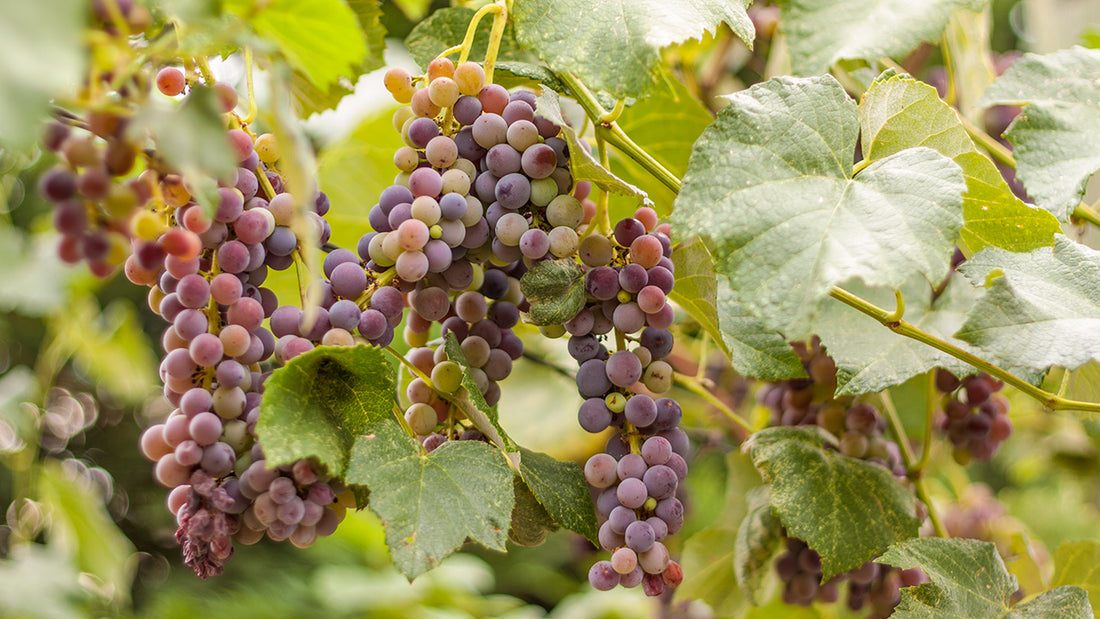Introduction
Excellent used as an ornamental, for summer shade, arbors or leafy walls. There are 2 basic classes of table grapes.
European varieties have tight skins, wine like flavors, high heat requirements for ripening, and are the most common grapes grown in California. Use fresh, dried, and for juices or wine. Susceptible to powdery mildew, they require regular dusting or spraying with sulfur or other mildew control.
American varieties have Concord-like flavor, moderate heat requirements, are late blooming and resistant to powdery mildew. Both classes may grow successfully in very warm sites at lower elevations; they require deep, moderately fertile soils and regular pruning for high quality and production. Self-fertile.
Heeling In
When your nursery stock arrives, it is best to plant them right away. If you cannot plant immediately (within a week of delivery), remove plastic bags that cover and keep the roots moist during shipment, and store them in a cool moist place like a root cellar or basement, making sure the roots stay moist and do not freeze. Or, you can “heel in” the plants to protect them. To heel in bare root plants outside, pick a location that is shielded from wind. Dig a trench with one side sloping and the other side vertically straight. Place the plants so that the roots are pointed toward the vertical side and the trunks / the sloping side supports stems. Cover the roots with soil and tamp it down to avoid air pockets. Heeling in should protect your plants until you are ready to plant. If you are unable to heel them in outside due to extremely cold temperatures, you can place the plants in a box with moist sawdust (do not, however, use cedar sawdust which is combustible) or dirt (by far the best and safest medium) covering the roots to hold them over. If using sawdust, be sure to carefully and regularly monitor the temperature to prevent “cooking” the roots if the sawdust starts to compost. The best preventative measure is to regularly water and aerate the pile without allowing the temperature to rise.
Cultural Requirements
Grapes prefer a light soil with good drainage and moderate to high fertility. They grow best in a deep soil with a pH between 5.5 to 7.0. Soil should be kept moist the first year after planting, but grapes will stand short dry periods in following years. Soaker hoses or drip tape work best.
Fertility
A spring application of fertilizer (a balanced blend) is recommended after planting them in the winter. They usually do not need too much supplemental fertilization unless your soil is depleted. Adding compost in a ring around the trunk each year is a good idea. Conduct a soil test to make sure phosphorus and potassium levels are adequate for proper fruit production.
Planting Instructions
Grapes should be planted 1” deeper than they were planted at the nursery, and spaced 8’ apart for maximum performance. The hole should be wide enough to spread out the roots. Insert a support stake, 2”–4” from the stem. Be sure the stake is as tall as you plan for the head. Plant in winter or early spring, pruning back top growth to two or three buds at planting time.
Pruning & Training
Prune anytime from Dec. through Feb. The first growing season should produce several shoots from the buds left at planting time. Select the strongest shoot to train as the main trunk and head it back to the height you want. The second growing season should produce at least four lateral branches. Four or more laterals may be utilized to meet individual requirements, such as arbors, trellises, etc. When pruning back vines, always leave a finger or stub with three or four buds. Light summer pruning may hasten fruit development. Grapes may produce an occasional fruit bunch the first year, and a good crop the second year if full sun is supplied. A southern exposure is to your advantage. Since there are many ways to grow and prune grapes, for more information see
The Fruit Gardener's Bible, by Lewis Hill.
Mildew
Powdery mildew can be a serious problem for European grapes (most American types seem to be immune to mildew). Use an organic fungicide labeled for powdery mildew to protect your crop.

